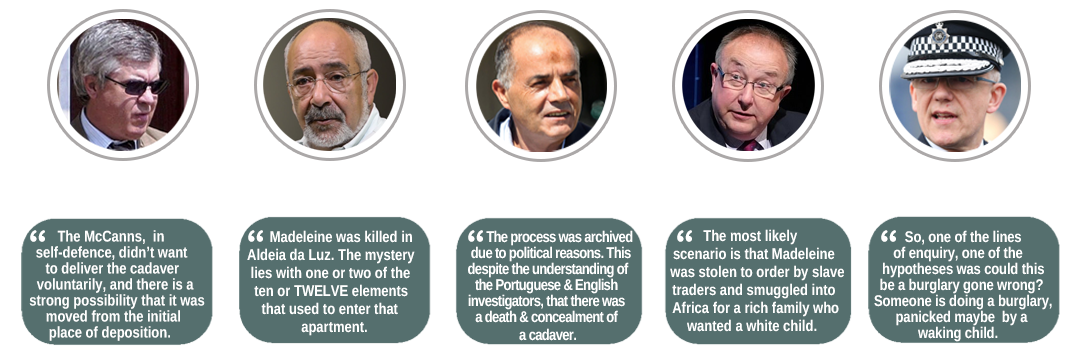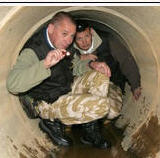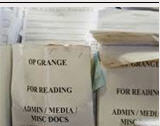Explanation of the DNA Analysis as detailed in the forensic report by John Lowe
The Complete Mystery of Madeleine McCann™ :: Madeleine Beth McCann :: McCann Case: The most important areas of research
Page 1 of 1 • Share
 Explanation of the DNA Analysis as detailed in the forensic report by John Lowe
Explanation of the DNA Analysis as detailed in the forensic report by John Lowe
Explanation of the DNA Analysis as detailed in the forensic report by John Lowe
Courtesy of Janine Bresnick
Background
We all have 2 copies of every gene/stretch of DNA – 1 inherited maternally, the other paternally.
At some genetic sites, there are short, repetitive motifs called markers. Each marker will contain a variable number of repeated motifs. In diagrammatic form, a marker pair at any one site, could be represented like this, where the letters, ACGT, are the 4 bases which make up DNA (AAGTC is an arbitrary motif);
Maternally inherited marker AAGTC|AAGTC|AAGTC|AAGTC|AAGTC|AAGTC|AAGTC|AAGTC| 8
Paternally inherited marker AAGTC|AAGTC|AAGTC|AAGTC| 4
So, at this marker site, the repeat pair values would be read as 8,4
This would be shown as 2 peaks on a readout, at that site with relative heights on a compter-generated graph as 8 and 4.
A second site could be represented as follows (where CCGTCTA is an arbitrary motif);
Maternally inherited marker CCGTCTA| CCGTCTA| CCGTCTA| CCGTCTA| CCGTCTA| CCGTCTA| CCGTCTA| CCGTCTA| CCGTCTA| 9
Paternally inherited marker CCGTCTA| CCGTCTA| CCGTCTA| CCGTCTA| CCGTCTA| 5
So, at this second site, the computer readout would be 9,5
As you can see, the exact sequence of the DNA is irrelevant. It is just the number of motif repeats that is of significance. Therefore, any reference to a small chance of errors occurring during amplification of the DNA ie bulking up Low Copy Number (LCN) by copying a small amount of starting material, is irrelevant. The actual DNA code (ACGT) is of no interest, as long as the repeats of varying lengths, are present. Even if say a C is erroneously copied as an A, G or T (which is how errors can occur with individual letters) it does not affect the validity of this technique. It is akin to spelling the word “THERE” of 5 letters long and erroneously transcribing it as “THEIR”. The second spelling has a different meaning but all we are looking at here, is, how long is the word and how many times is it repeated? We don’t care about the meaning for this kind of analysis.
Creating profiles using the technique
Because the number of repeats each of us has at each of these sites is random, we can produce a unique profile, in terms of pairs of repeat values, over several sites.
If we were to look at 10 sites, with 2 values at each site, we will have 20 values, in pairs and that is an important thing to bear in mind. The power of the technique in terms of producing UNIQUE profiles is that we are not looking at 20 random sites giving 20 random values, but 10 pairs of values at 10 sites.
As touched on earlier, the computers that produce the data, do so by giving “peak heights” according to the length of the repeat. So a repeat length of 2, has a peak height of 2 units, a repeat value of 3, a peak height of 3 units etc., etc. These are the peaks referred to by Lowe.
The table below shows the way a unique profile of a child would be inherited from a given set of parental markers. The full set of 20 markers, in terms of 10 pairs of 2 values can be called the inherited genotype or genetic profile.
In the table below, the values I’ve listed at line “possible inherited marker sets at each site (child)”, are derived by combining each maternal value and with each paternal value in turn, resulting in 4 possible combinations. I have used arbitrary numbers for illustrative purposes.
NB at marker site no.8, I’ve shown how, if both parents possess the same number of repeats at a given site, there will be a 1 in 4 chance that a child could inherit the same number twice. A child inheriting the same number of repeats from both parents, in this case 9, will produce a profile that appears with only one peak at that site and in this example, it will have a height of 9 units. Cf the Lowe report where he explains that the DNA from the Rothley pillowcase (Madeleine’s control sample) yielded an apparent complete profile of 19 markers, not 20, because at one site, there was an inheritance of the same number of repeats from both Kate and Gerry. In fact, there would have been 2 peaks, superimposed on each other so appear as 1. Therefore, when Lowe says there were 19 markers this should strictly be described as 20 but 19 in terms of peaks.
Looking at the above, to produce a unique genetic profile for an offspring during reproduction, we randomly take 1 set of marker values (of the 4 we have to choose from) at each site. I’ve randomly taken one marker set at each site to produce an example of a profile shown below. It can then be seen that if we were to analyse these marker sets, we would get 2 peaks at each site on a readout, except site no. 8 in my example below, because of the inheritance pattern explained earlier. The probability of inheriting any one marker pair from a possibility of 4 options shown in the table above, is 1 in 4 or 0.25
What is the probability that the crime scene DNA described as having a 15/19 marker match did or did not come from Madeleine?
The probability of inheritance of any single full genotype at all 10 sites, from one set of parents = 0.25 multiplied by 0.25, 10 times, so (0.25)10 = 0.00000095 which is just over 1 million to 1.
Therefore, there are just over 1 million permutations of inheritance of 10 pairs of markers from any 2 parents. It’s a very powerful technique because we look at marker PAIR values. Lowe says that we all share these repeats and if you were to look at any one person’s DNA, you would find a selection of these numbers. That is true, but the chances of any value represented along with its paired value at any single site is not at all likely. As you can see, even inheriting the same pair values at one site among siblings is a 1 in 4 chance. Looking at the population as a whole, variation in repeat values at each site is much larger.
According to Lowe, the profile of the crime scene DNA yielded 15 markers that were identical to that of Madeleine’s pillowcase DNA. He says 15/19 because 4 markers were missing due to the DNA being degraded. Because the analysis is done as pair values at each site and you can’t have half a site nor half a pair value, it should be 16/20. The pillowcase DNA did have 20 markers which looked like only 19 as described above. If you look along the profile in the table above, reading from site 1 to 8, you will see that in fact, by column 8, you have 16 markers even though 2 are identical.
In this case, the probability of inheriting those same 8 pairs of markers at those sites from the same parents is (0.25)8= 0.000015 or 66.66 thousand to 1 chance.
What is the probability that a random stranger, not related to Madeleine, deposited DNA with those exact same 16 marker pairs over the 8 sites with a complete match to Madeleine? Many million to 1.
Courtesy of Janine Bresnick
Background
We all have 2 copies of every gene/stretch of DNA – 1 inherited maternally, the other paternally.
At some genetic sites, there are short, repetitive motifs called markers. Each marker will contain a variable number of repeated motifs. In diagrammatic form, a marker pair at any one site, could be represented like this, where the letters, ACGT, are the 4 bases which make up DNA (AAGTC is an arbitrary motif);
Maternally inherited marker AAGTC|AAGTC|AAGTC|AAGTC|AAGTC|AAGTC|AAGTC|AAGTC| 8
Paternally inherited marker AAGTC|AAGTC|AAGTC|AAGTC| 4
So, at this marker site, the repeat pair values would be read as 8,4
This would be shown as 2 peaks on a readout, at that site with relative heights on a compter-generated graph as 8 and 4.
A second site could be represented as follows (where CCGTCTA is an arbitrary motif);
Maternally inherited marker CCGTCTA| CCGTCTA| CCGTCTA| CCGTCTA| CCGTCTA| CCGTCTA| CCGTCTA| CCGTCTA| CCGTCTA| 9
Paternally inherited marker CCGTCTA| CCGTCTA| CCGTCTA| CCGTCTA| CCGTCTA| 5
So, at this second site, the computer readout would be 9,5
As you can see, the exact sequence of the DNA is irrelevant. It is just the number of motif repeats that is of significance. Therefore, any reference to a small chance of errors occurring during amplification of the DNA ie bulking up Low Copy Number (LCN) by copying a small amount of starting material, is irrelevant. The actual DNA code (ACGT) is of no interest, as long as the repeats of varying lengths, are present. Even if say a C is erroneously copied as an A, G or T (which is how errors can occur with individual letters) it does not affect the validity of this technique. It is akin to spelling the word “THERE” of 5 letters long and erroneously transcribing it as “THEIR”. The second spelling has a different meaning but all we are looking at here, is, how long is the word and how many times is it repeated? We don’t care about the meaning for this kind of analysis.
Creating profiles using the technique
Because the number of repeats each of us has at each of these sites is random, we can produce a unique profile, in terms of pairs of repeat values, over several sites.
If we were to look at 10 sites, with 2 values at each site, we will have 20 values, in pairs and that is an important thing to bear in mind. The power of the technique in terms of producing UNIQUE profiles is that we are not looking at 20 random sites giving 20 random values, but 10 pairs of values at 10 sites.
As touched on earlier, the computers that produce the data, do so by giving “peak heights” according to the length of the repeat. So a repeat length of 2, has a peak height of 2 units, a repeat value of 3, a peak height of 3 units etc., etc. These are the peaks referred to by Lowe.
The table below shows the way a unique profile of a child would be inherited from a given set of parental markers. The full set of 20 markers, in terms of 10 pairs of 2 values can be called the inherited genotype or genetic profile.
In the table below, the values I’ve listed at line “possible inherited marker sets at each site (child)”, are derived by combining each maternal value and with each paternal value in turn, resulting in 4 possible combinations. I have used arbitrary numbers for illustrative purposes.
NB at marker site no.8, I’ve shown how, if both parents possess the same number of repeats at a given site, there will be a 1 in 4 chance that a child could inherit the same number twice. A child inheriting the same number of repeats from both parents, in this case 9, will produce a profile that appears with only one peak at that site and in this example, it will have a height of 9 units. Cf the Lowe report where he explains that the DNA from the Rothley pillowcase (Madeleine’s control sample) yielded an apparent complete profile of 19 markers, not 20, because at one site, there was an inheritance of the same number of repeats from both Kate and Gerry. In fact, there would have been 2 peaks, superimposed on each other so appear as 1. Therefore, when Lowe says there were 19 markers this should strictly be described as 20 but 19 in terms of peaks.
| Marker Site | 1 | 2 | 3 | 4 | 5 | 6 | 7 | 8 | 9 | 10 | ||||||
| Maternal repeat lengths (Maternal genotype) | 8,4 | 5,9 | 6,8 | 3,7 | 5,6 | 8,4 | 4,7 | 9,4 | 3,8 | 5,4 | ||||||
| Paternal repeat lengths (paternal genotype) | 7,9 | 4,3 | 9,3 | 6,4 | 8,9 | 5,5 | 3,8 | 9,3 | 7,6 | 3,7 | ||||||
| Possible inherited marker sets at each site (child) | 8,7 8,9 4,7 4,9 | 5,4 5,3 9,4 9,3 | 6,9 6,3 8,9 8,3 | 3,6 3,4 7,6 7,4 | 5,8 5,9 6,8 6,9 | 8,5 8,5 4,5 4,5 | 4,3 4,8 7,3 7,8 | 9,9 9,3 4,9 4,3 | 3,7 3,6 8,7 6,8 | 5,3 5,7 4,3 4,7 |
| Randomly inherited profile | 4,7 | 9,3 | 6,9 | 3,4 | 6,8 | 4,5 | 4,8 | 9,9 | 8,6 | 5,7 |
| Probability of inheriting that particular marker pair | 0.25 | 0.25 | 0.25 | 0.25 | 0.25 | 0.25 | 0.25 | 0.25 | 0.25 | 0.25 |
The probability of inheritance of any single full genotype at all 10 sites, from one set of parents = 0.25 multiplied by 0.25, 10 times, so (0.25)10 = 0.00000095 which is just over 1 million to 1.
Therefore, there are just over 1 million permutations of inheritance of 10 pairs of markers from any 2 parents. It’s a very powerful technique because we look at marker PAIR values. Lowe says that we all share these repeats and if you were to look at any one person’s DNA, you would find a selection of these numbers. That is true, but the chances of any value represented along with its paired value at any single site is not at all likely. As you can see, even inheriting the same pair values at one site among siblings is a 1 in 4 chance. Looking at the population as a whole, variation in repeat values at each site is much larger.
According to Lowe, the profile of the crime scene DNA yielded 15 markers that were identical to that of Madeleine’s pillowcase DNA. He says 15/19 because 4 markers were missing due to the DNA being degraded. Because the analysis is done as pair values at each site and you can’t have half a site nor half a pair value, it should be 16/20. The pillowcase DNA did have 20 markers which looked like only 19 as described above. If you look along the profile in the table above, reading from site 1 to 8, you will see that in fact, by column 8, you have 16 markers even though 2 are identical.
In this case, the probability of inheriting those same 8 pairs of markers at those sites from the same parents is (0.25)8= 0.000015 or 66.66 thousand to 1 chance.
What is the probability that a random stranger, not related to Madeleine, deposited DNA with those exact same 16 marker pairs over the 8 sites with a complete match to Madeleine? Many million to 1.
____________________
PeterMac's FREE e-book
Gonçalo Amaral: The truth of the lie
CMOMM & MMRG Blog

Jill Havern- Forum Owner & Chief Faffer

- Posts : 29107
Activity : 41843
Likes received : 7716
Join date : 2009-11-25
Location : Parallel universe
 Similar topics
Similar topics» Madeleine McCann: Explanation of the DNA Analysis as detailed in the forensic report by John Lowe
» John Lowe Report - Forensics
» John Lowe tells us there was a MATCH to Maddie in the car & more about DNA & FORENSICS
» Why was FORENSIC REPORT changed? - Maddie McCann CMTV April 23rd 2016
» ‘Too hot’ report on police leaks to media was buried as Leveson Inquiry ignored Met’s bombshell intelligence report
» John Lowe Report - Forensics
» John Lowe tells us there was a MATCH to Maddie in the car & more about DNA & FORENSICS
» Why was FORENSIC REPORT changed? - Maddie McCann CMTV April 23rd 2016
» ‘Too hot’ report on police leaks to media was buried as Leveson Inquiry ignored Met’s bombshell intelligence report
The Complete Mystery of Madeleine McCann™ :: Madeleine Beth McCann :: McCann Case: The most important areas of research
Page 1 of 1
Permissions in this forum:
You cannot reply to topics in this forum































